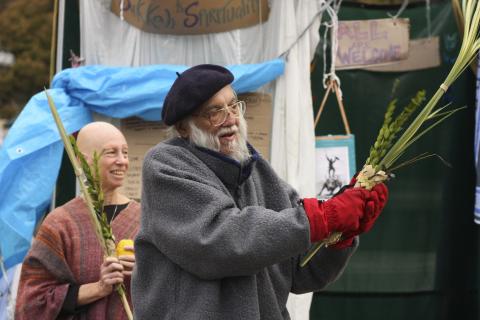Submitted by Rabbi Arthur Waskow on

Click on this photo (by Rachel Playa) to expand it. It comes from the sukkah we helped build at City Hall as part of the “Occupy Philadelphia” encampment. See the end of this letter for a fuller explanation.
Last week I wrote that in regard to “Occupy Wall Street,” transformative questions may be more important than answers at this point So I want to share some questions with you. I invite your responses in the Comments section below.
I. The first set of questions come from my work in the Steering Committee of a new gathering called the Council of Elders, made up of veteran leaders of the civil rights movement who have individually continued our commitment to nonviolent action for justice and are now planning to work together in the present American social crisis. The Steering Committee last week decided to actively support “Occupy Wall Street. ”
Taking part by Email before the meeting, I wrote this:
The Elders are taking shape just as American youth are creating new forms of political action focused around “Wall Street” – that is, the growth toward overwhelming top-down power of the ultra-rich and great corporations. This offers us a powerful role. I suggest that we explicitly see ourselves as connected to this movement.
For example: We begin by asking two key strategic questions:
(a) Which few corporations or concentrations of wealth pose great danger -- even more than others –- to American democracy, to the possibility of justice for the Black and Hispanic communities and the poor of all colors, and to the sustainability of life on this planet?
(b) Which of these are the most vulnerable to nonviolent public pressure from workers, customers, public activists, etc? (Possible examples: the Agro-corporate system in its treatment of farm workers, supermarket and other food workers, and the safety, quality, and price of food itself. Or: one of the ”Health-care” giants. Or: Exxon. Or: Goldman Sachs. )
Next: Imagine that 20 members of The Elders appear publicly at the HQ of the designated top-down center, asking it to make a small but crucial number of changes, focused not on specific small reforms but on serious democratization (major workers’ and consumers’ voice in management, recognition of unions, recognition of consumer oversight groups, opening company books to independent observation, etc).
Then: If met with refusal, the Elders call for boycotts, mass protests, vigils, nonviolent worker take-overs /sit-downs in plants and offices, etc. The Elders themselves take part in these actions.
I’m sending this sketch not with the notion it’s a blueprint but in the hope it helps stir our ideas for ways of bringing our experience and our visibility to bear on deepening and broadening the profound social change our country thirsts for. This moment of American and world history seems made for strategically planned and sharply incisive action.
II. Should The Shalom Center pursue an action-path that might be called "Occupy Religion"? The “Occupy Wall Street” model is to face and resist top-down corporate power. Some parts of American religious life imitate the model of top-down corporate power in their own behavior; some support the top-down corporate political and economic agenda; and some actually receive massive financial support from the corporations.
Do all who are faithful to the Spirit, regardless of their individual forms of practice and participation in their own specific community, have an obligation to face top-down, anti-woman, anti-gay, anti-immigrant, anti-minority, xenophobic, anti-Earth, pro-corporate expressions of organized religion?
III. In a number of cities, local police forces have been using repressive measures against “Occupy Wall Street” encampments. The “local” police seem to be in touch with each other, and are simultaneously using techniques that were developed to respond to the civil-rights, anti-war, women’s rights, and gay rights movements of the 1960s and since and the anti-globalization movement that surfaced in Seattle in 2001.
Do these seemingly separate police responses signal an important national threat to freedom of speech and assembly? It would not be surprising if a serious challenge to corporate power brought on such a response; it has in the past. Should allies of “Occupy Wall Street” be alert to civil liberties issues at this level?
Again, we welcome your wisdom. I invite you to send us your own thoughts on these three sets of questions. Thanks!
For us to pursue any of these approaches, we need your help with money as well as wisdom. Please contribute by clicking on the purple “Donate” to the left. Thanks again!
About the photos: We did the traditional ceremony of invoking abundance, the “waving of the lulav” in the seven (!) directions of the world (Rabbi Phyllis Berman, my life-partner, co-author, and co-activist and I are in the photo); I spoke on the implications of “Free Kol Nidrei” and “Free Sukkot” for the emergence of Transformational Judaism; and Rabbi Linda Holtzman of Mishkan Shalom led us in applying the biblical story of Ruth to activism today on behalf of immigrant farm workers.



















